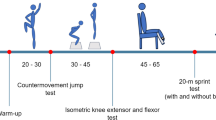Abstract
Background and aims
Although chair seat height affects the performance of sit-to-stand movement, no previous study has examined the influence of chair seat height on the 30-second chair stand test (CST).
Methods
Fifty-five community-dwelling older adults (age 70.0 ± 6.3 years) performed the test from the standard height of 43 cm and then from five randomly ordered seat heights from 80 to 120 % of each participant’s lower leg length.
Results
Chair seat height significantly influences the performance of community-dwelling older adults’ 30-s CST (F = 57.50, p < 0.001). The mean score for standard conditions was significantly lower from those at 120, 110, and 100 % conditions (p < 0.05). No significant difference was observed between the standard and 80 % conditions (p > 0.95) and between the standard and 90 % conditions (p = 0.353). When comparing the scores between the randomly ordered chair seat heights, all comparisons were significantly different (p < 0.001) except for the difference between the 120 and 110 % conditions (p = 0.104).
Conclusion
Chair seat height’s relation to the lower leg length should be considered when interpreting 30-s CST scores. Additionally, it is necessary to optimize the chair seat height when using the 30-s CST as an outcome measure for exercise intervention or to screen for people with weaker lower extremities.
Similar content being viewed by others
References
United Nations. World population ageing: 1950–2050. http://www.un.org/esa/population/publications/worldageing19502050/. Acessed 3 July 2012
U.S. Department of Health and Human Services and U.S. Department of State. Why population aging matters: a global perspective. http://www.nia.nih.gov/sites/default/files/WPAM.pdf. Accessed 3 July 2012
Rikli RE, Jones CJ (1999) Development and validation of a functional fitness test for community-residing older adults. J Aging Phys Act 7(2):129–161
MacFarlane DJ, Chou KL, Cheng YH, Chi I (2006) Validity and normative data for thirty-second chair stand test in elderly community-dwelling Hong Kong Chinese. Am J Hum Biol 18(3):418–421
Rikli RE, Jones CJ (1999) Functional fitness normative scores for community-residing older adults, ages 60–94. J Aging Phys Act 7(2):162–181
Chen HT, Lin CH, Yu LH (2009) Normative physical fitness scores for community-dwelling older adults. J Nurs Res 17(1):30–41
Janssen WGM, Bussmann HBJ, Stam HJ (2002) Determinants of the sit-to-stand movement: a review. Phys Ther 82(9):866–879
Rodosky MW, Andriacchi TP, Andersson GBJ (1989) The influence of chair height on lower limb mechanics during rising. J Orthop Res 7(2):266–271
Weiner DK, Long R, Hughes MA, Chandler J, Studenski S (1993) When older adults face the chair-rise challenge. A study of chair height availability and height-modified chair-rise performance in the elderly. J Am Geriatr Soc 41(1):6–10
Heung THM, Ng SSM (2009) Effect of seat height and turning direction on the timed up and go test scores of people after stroke. J Rehabil Med 41(9):719–722
Demura S, Yamada T (2007) Height of chair seat and movement characteristics in sit-to-stand by young and elderly adults. Percept Mot Skills 104(1):21–31
Csuka M, McCarty DJ (1985) Simple method for measurement of lower extremity muscle strength. Am J Med 78(1):77–81
Tang HW, Lin PS, Cheng HS, Liu HH, Liu SC, Wong AMK (2008) The relationships between knee extensor muscle strength and 30-s chair stand test in community-dwelling elderly of different health statuses. Formos J Phys Ther 33(5):287–293
Mazza C, Benvenuti F, Bimbi C, Stanhope SJ (2004) Association between subject functional status, seat height, and movement strategy in sit-to-stand performance. J Am Geriatr Soc 52(10):1750–1754
Martin AD, Carter JEL, Hendy KC, Malina RM (1988) Segment lengths. In: Lohman TG, Roche AF, Martorell R (eds) Anthropometric standardization reference manual. Human Kinetics Pub, Champaign, pp 9–25
McCarthy EK, Horvat MA, Holtsberg PA, Wisenbaker JM (2004) Repeated chair stands as a measure of lower limb strength in sexagenarian women. J Gerontol A Biol Sci Med Sci 59(11):1207–1212
Krause MP, Januario RSB, Hallage T, Haile L, Miculis CP, Gama MPR et al (2009) A comparison of functional fitness of older Brazilian and American women. J Aging Phys Act 17(4):387–397
Yamada T, Demura S (2004) Influence of the relative difference in chair seat height according to different lower thigh length on floor reaction force and lower-limb strength during sit-to-stand movement. J Physiol Anthropol Appl Hum Sci 23(6):197–203
Acknowledgments
This study was supported by grant TCRPP100005 from the Tzu Chi Foundation, Taiwan.
Conflict of interest
None.
Author information
Authors and Affiliations
Corresponding author
Rights and permissions
About this article
Cite this article
Kuo, YL. The influence of chair seat height on the performance of community-dwelling older adults’ 30-second chair stand test. Aging Clin Exp Res 25, 305–309 (2013). https://doi.org/10.1007/s40520-013-0041-x
Received:
Accepted:
Published:
Issue Date:
DOI: https://doi.org/10.1007/s40520-013-0041-x




